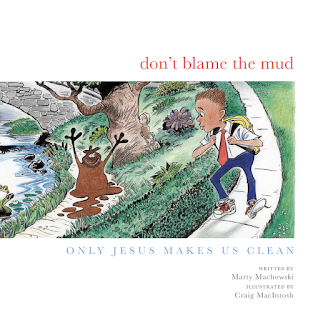It’s never too early to teach that bad choices lead to bad consequences
Part 2 of an
interview with Marty Machowski,
Author of Don’t Blame the Mud
For young readers and families, Don’t
Blame the Mud (New Growth Press) paints a vivid and accurate
picture of sin and God’s plan of redemption. Written by best-selling children’s
author Marty Machowski, this beautifully illustrated picture book teaches
children how to recognize the lure of temptation and the truth that bad choices
lead to bad consequences.
One day, Max takes the muddy path along the creek home, disregarding his
mother’s reminder to keep his school clothes clean. After crashing into a mud
puddle, he tries to hide his mistake and discovers the stain of his sin goes
deeper than the mud he can wash away. In this lovable, relatable, and
heartwarming tale, Max learns his heart needs to be cleaned, and Jesus is the
only one who can wash away his sin.
By clearly articulating the gospel, Don’t Blame the Mud helps parents create an
environment of confession so kids can own up to their own mistakes—in the
freedom of Christ—rather than place the blame elsewhere. Parents, teachers, and
caretakers can help children identify with the real-life draw of temptation and
the real-life consequences of sin, understanding the value of God’s salvation
through the cross. Instead of teaching kids how to deal with a problem,
Machowski uncovers the real issue of sin and provides a gospel answer.
Q: Why did
you choose to personify sin and temptation as the character Mud?
I wanted a situation that would work for all kids,
all around the world, no matter what culture they came from. From my
experience, just about every kid in the world has heard his or her mom or dad
say, “Don’t get your clothes dirty,” and all kids have faced the decision as to
whether or not they are going to obey that command. I remember times as a kid
where I chose to play football in a muddy field, telling myself I could keep my
good school clothes clean, only to end up getting them muddy. That’s where the
idea for the story came from. In fact, in the first draft, I had Max playing
football in a muddy field—a picture of me as a kid.
I wanted a fun character that would bring interest
to the story and help children identify with the real-life draw of temptation and
the real-life consequences of sin. The Mud character does both of those things.
Q: Why is it
important to teach young children about sin?
Without an understanding of sin and the holiness
of God, our children won’t understand the value of God’s salvation through the
cross. Unless you see that you have a problem, you don’t think you need a
solution.
Q: How should
parents use the story with their children?
I think Don’t
Blame the Mud is a story families can read again and again. The theological
explanations at the end of the story are designed to help children understand
the underlying biblical truths presented by the story. So, reading Don’t
Blame the Mud again and again will help children learn those underlying
truths.
Q: What
advice would you give parents who desperately want to see their children become
Christians and follow Jesus, but their children aren’t responding like Max in
your story?
I wanted Max to become a Christian in the story as
a part of the gospel presentation to teach children how the gospel is meant to
affect us. But yes, you are correct to point out life is rarely that simple. I
would reassure parents with the words of the Apostle Paul, who encouraged the Galatians,
“Let us not grow weary of doing good, for in due season we will reap, if we do
not give up” (Galatians 6:9 ESV).
For parents with struggling children, I wrote a
devotional book to encourage them called Parenting
First Aid. In it I share my own personal parenting stories and tales of folks
I’ve met along the way. I connect the stories to scriptures in a way that’s
designed to blow a fresh wind of faith into the struggling parent’s heart.
Q: Don’t Blame the Mud is your first
venture into writing a short picture book. How was the experience different
than the other books you have written?
Even though there are far fewer words in Don’t Blame the Mud than any of my other
books, it took me ten times as much time per word to write. I took the better
part of six months and hundreds of hours writing Don’t Blame the Mud. I have more than twenty rewrites in my working
files. It started out as a rhyming book similar to Dr. Seuss since it’s a book
for that audience, an early reader book for the younger elementary grades.
However, I later changed it back to prose as I
didn’t want to have to force the important sections to rhyme. I left a few of
the rhyming lines in the book as I think they help those lines to stand out.
Learn
more at www.martymachowski.com.
He can also be found on Twitter
(@MartyMachowski).
Click here to order your copy!


Comments